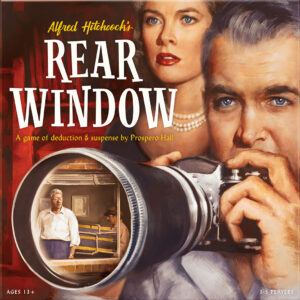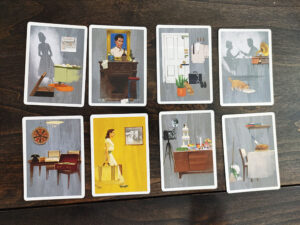 Seeing as how I’m Board Game Grow’s resident movie person, it should come as no surprise that I had a movie-themed wedding. Every table was a “theater” and the guests’ seating cards were tickets that granted them access to the showing. My eventual wife and I each picked half the films that would be represented. Coincidentally, we both prominently featured a film by Alfred Hitchcock. My wife’s pick was Vertigo, her favorite film of his. For me, I went with North by Northwest—for my money one of the most purely entertaining films ever produced.
Seeing as how I’m Board Game Grow’s resident movie person, it should come as no surprise that I had a movie-themed wedding. Every table was a “theater” and the guests’ seating cards were tickets that granted them access to the showing. My eventual wife and I each picked half the films that would be represented. Coincidentally, we both prominently featured a film by Alfred Hitchcock. My wife’s pick was Vertigo, her favorite film of his. For me, I went with North by Northwest—for my money one of the most purely entertaining films ever produced.
BGQ’s fearless leader Tony Mastrangeli must have known that we selected these films because he, in his rather finite wisdom, assigned me to review a game based on a Hitchcock movie that neither my wife nor I selected as our favorite. Rear Window is designed by the folks at Prospero Hall and is for 3-5 suspense-loving nosy neighbors and plays briskly in under an hour.
Gameplay Overview:
Rear Window is a cooperative(ish) deduction(ish) game in which one player will silently give vague clues to the other players in an effort to get them to guess what information belongs where. (Usually. Sometimes the silent player will want to be sneaky because of… game design reasons?) The clue giver is known as the Director and they’ll sit behind a screen adorned with the face of Hitchcock himself. The Director is aware of all the game’s mysteries from the outset. During each of the game’s four days of play, the Director will play eight cards in pairs of two to a series of windows overlooking the courtyard. The other players—the Watchers—will look at this abstract information and attempt to discern where the Director is guiding them.

To put a finer point on this concept: each window will have two “aspects” that need to be identified. The first is what person or duo is in that apartment and the second is a general description of what those people might be up to. So, for instance, if the Director knows that the “Song Writer” character from the movie is in apartment A and that he is heartbroken, he or she might play cards matching the color associated with the Song Writer and, perhaps, a window card that shows a dying rose to signify heartbrokenness. After the Director has laid out all the clues for the day, the Watchers can discuss the information and then make their guesses. The Director will then silently tell them how close they got (scoring them out of eight points) and move on to the next day. If the Watchers ever get to seven or eight correct guesses, then everyone wins and everyone is happy.
That is, of course, unless there’s a murrrderrrr. (dun-dun-dunnnn!)

Yes, the game also involves secret murdering just like in the movie, although that’s where things get a little confusing. You see, the Director knows there’s been a murder from the start of the game, but for some reason still needs the Watchers to get most of the information correct except the whole murder part. So, if there was a murder, the game is now only semi-cooperative, but only one person knows it’s semi-cooperative. In this case, the Watchers need to sniff out the murder and where it happened just like all the other information, while the Director needs the Watchers to get everything right except the murder. Make sense? No? Well, we’re moving on anyway.
There are additional rules as well including four powers the Watchers can summon during the game (based on the film’s main characters, of course) and an advanced ruleset of character “traits” that require pairing up characters; this person is about to break up with that person and so on. This added wrinkle in the mystery is very difficult to convey but is also a lot of fun to puzzle out.
Whether by complete win, by complete failure, or by sneaky Director-hiding-a-murder win, the game ends at the end of the fourth day.

Game Experience:
Just by reading through this description of the game, I’ll bet most people in the audience are saying the same thing: “So this is just Mysterium with a Hitchcock theme, right?” And, well, kinda. The game does play a lot like Mysterium in the way clues are given and the types of abstracted artwork players are contending with. But Rear Window offers a much more streamlined game arc than Mysterium. For the most part, Rear Window is incredibly easy to intuit. “I need you to get to these answers.” Very straightforward. The complicating factor, of course, is the game’s murder twist, which may or may not even occur.

I guess I understand the logic behind including a “suspenseful” element to a game featuring the Master of Suspense. (That’s Hitchcock for those not in the know. And he didn’t direct horror films, no matter what most people believe.) But despite the inherent logic surrounding its inclusion, the idea that the Watchers have to sniff out a potential murder that may or may not even occur is a bit odd. It’s also somewhat frustrating since the game can already be quite challenging as it is. (Not impossible, mind you, as I was once part of a Watcher team that got everything correct including the circumstances surrounding an obfuscated murder.)
That being said, without the potential murder complicating the game, it might actually be far too straightforward as a cooperative deduction game. As such, the gameplay experience lands somewhat in the middle; it’s always fun to play and fairly challenging but can also feel as though the game is cheating players through no fault of their own.
Final Thoughts:
Rear Window—like nearly all of Prospero Hall’s games—is an above-average game with fantastic artwork and exceptional theme integration. It’s also probably not the most exciting (semi-) cooperative game on the market, nor is it the tensest pure deduction game you can play. Ultimately, that’s what the designers were definitely going for and adding in the “murder” twist was a clear attempt to differentiate this design from what others have done. For my money, the advanced and interacting character traits are the more appealing way to play the game, and simply removing the possibility of a murder to make the game purely cooperative is much more fun.
Final score: 3.5 Stars. Rear Window takes a classic suspense film and distills its core story into a quick-playing and challenging kinda sorta coop deduction game that won’t disappoint those looking for a voyeuristic good time.
 Hits:
Hits:
• Great artwork
• Theme shines through
• Easy to play
• Short playtime
Misses:
• Setup takes a bit longer than it should
• Not especially innovative
• Semi-coop “twist” isn’t always a fun way to end the game
• Murder mechanism is intriguing, but doesn’t feel fully fleshed out





















